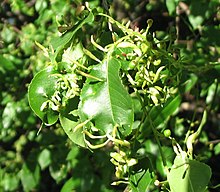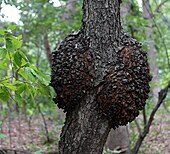Prunus serotina
An almond-like odour is released when a young twig is scratched and held close to the nose, revealing minute amounts of cyanide compounds produced and stored by the plant as a defense mechanism against herbivores.Removal is not always practical, though, because these trees often grow in very large numbers on farms, taking advantage of the light brought about by mowing and grazing.Black cherry is closely related to the chokecherry (P. virginiana), which tends to be shorter (a shrub or small tree) and has smaller, less glossy leaves.Gleason and Cronquist (1991) describe P. serotina as "[f]ormerly a forest tree, now abundant as a weed-tree of roadsides, waste land, and forest-margins".[22] It is a moderately long-lived tree, with ages of up to 258 years known, though it is prone to storm damage, with branches breaking easily; any decay resulting, however, only progresses slowly.All Prunus species have hard seeds that benefit from scarification to germinate (which in nature is produced by passing through an animal's digestive tract).[24] P. serotina hosts the caterpillars of more than 450 species of butterflies and moths, including those of the eastern tiger swallowtail (Papilio glaucus), cherry gall azure (Celastrina serotina), viceroy (Limenitis archippus), and red-spotted purple/white admiral (Limenitis arthemis) butterflies and the cecropia (Hyalophora cecropia), promethea (Callosamia promethea), polyphemus (Antheraea polyphemus), small-eyed sphinx (Paonias myops), wild cherry sphinx (Sphinx drupiferarum), banded tussock (Halysidota tessellaris), spotted apatelodes (Apatelodes torrefacta), and band-edged prominent moths.

Black Cherry (disambiguation)Conservation statusLeast ConcernIUCN 3.1Scientific classificationPlantaeTracheophytesAngiospermsEudicotsRosidsRosalesRosaceaePrunusPrunus subg. PadusBinomial nameSynonymsdeciduouscherriesleavesdrupessourwoodcyanideherbivoresapricotscyanogenic glycosidesamygdalinhydrogen cyanideamygdalin beta-glucosidaseprunasin beta-glucosidasemandelonitrile lyasefencerowssubspeciesvarietiesEriophyes cerasicrumenaBlack knotpioneer speciesMidwestblack walnutblack locusthackberrysoil bankscarificationeastern tiger swallowtail (Papilio glaucus)cherry gall azure (Celastrina serotina)viceroy (Limenitis archippus)red-spotted purple/white admiral (Limenitis arthemis)cecropia (Hyalophora cecropia)promethea (Callosamia promethea)polyphemus (Antheraea polyphemus)small-eyed sphinx (Paonias myops)wild cherry sphinx (Sphinx drupiferarum)banded tussock (Halysidota tessellaris)spotted apatelodes (Apatelodes torrefacta)Hyphantria cuneaeastern tent caterpillarNahuatltimbercabinetrylb/cu ftornamental treenaturalizedinvasive speciesbiodiversityAlabama black cherryIUCN Red List of Threatened SpeciesNorth Carolina State UniversityNorth Carolina Agricultural and Technical State UniversityLady Bird Johnson Wildflower CenterUniversity of Texas at AustinMissouri Botanical GardenHarvard University HerbariaBibcodePeattie, Donald CulrossBonanza BooksBronxville, New YorkMorton, JuliaAngier, BradfordPlants for a FutureWikidataWikispeciesiNaturalistMoBotPFNatureServeNSWFloraOpen Tree of LifePlant ListTropicos